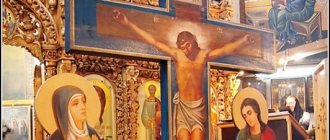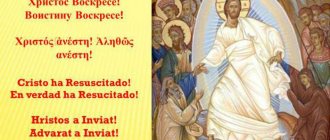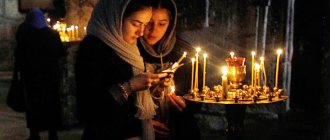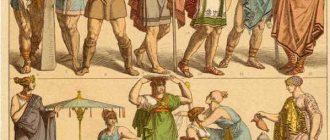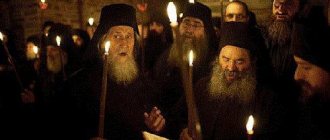When people become like angels
The Cherubic Hymn usually leaves a lasting impression on everyone, even those who do not often attend church services. It is sung at all full Liturgies, with the exception of Maundy Thursday and Holy Saturday, when they are replaced, respectively, by the church hymns “Thy Mystical Supper” and “Let all flesh be silent.” In the Liturgy of the Presanctified Gifts, its place is taken by the hymn “Now the Powers of Heaven.”
It is usually performed slowly and drawn out, which is why it may seem long, although in reality it is not. Her words in Church Slavonic sound like this:
Even as the Cherubim secretly form, and the life-giving Trinity sings the thrice-holy hymn, let us now put aside all worldly cares. As if we were to raise up the King of all, the angels invisibly brought us to the chinmi. Alleluia. Alleluia. Alleluia.
As we see, although laconic in form, the Cherubic Song is very voluminous in content. In fact, it can be called a shortened, condensed version of the song “Let all flesh be silent.” Taking its place in the service when the Great Entrance takes place, it marks a symbolic transition from the preparatory part (the Liturgy of the Catechumens) to the main part of the service - the Liturgy of the Faithful.
The main task of the song-prayer is to lift a person above the vain worries of everyday life and direct all his heart and attention upward, to the Heavenly Sacrament, which is about to take place. In this, we all, at least for a moment, can and are called to become like the angels, whose main task is to constantly stand before the Throne of God and glorify Him. For us, this is most possible precisely during the Divine Liturgy.
DIVINE LITURGYLITURGY OF THE FAITHFUL
This is the name of the third part of the Liturgy because only the faithful can attend it,
that is, baptized. It can be divided into the following parts: 1) transferring honest Gifts from the altar to the throne; 2) preparing believers for the consecration of the Gifts; 3) consecration (transubstantiation) of the Gifts; 4) preparing believers for communion; 5) communion and 6) thanksgiving for communion and dismissal.
TRANSFER OF HONEST GIFTS FROM THE ALTAR TO THE THRONE
After inviting the catechumens to leave the temple, two short litanies are pronounced and the Cherubic hymn is sung: “Even though the Cherubim secretly form, and the Life-Giving Trinity sings the thrice-holy hymn, let us now put aside all worldly cares. As if we will raise up the King of all, the angels invisibly bring us to the chinmi. Alleluia
(three times)
".
In Russian, this song reads like this: “We, mysteriously depicting the Cherubim and singing the thrice-holy hymn to the Trinity, which gives life, will now leave concern for everything everyday, so that we can glorify the King of all, Whom the invisibly angelic ranks solemnly glorify. Praise be to God! Individual words of the Cherubic song mean: secretly forming
- mysteriously portraying or mysteriously presenting oneself;
life-giving
- life-giving;
chanting
- chanting;
put it aside
- leave it;
worldly care
- care for everyday things;
like yes
- so that;
let's raise
- raise, glorify;
dorinoshima
- solemnly worn, glorified (
"dori"
is a Greek word and means spear, so
"dorinoshima"
means spear-carrying; in ancient times, wanting to solemnly glorify chests or military leaders, they put them on shields and, raising them up, carried them on these shields in front of troops, and the shields were supported by spears, so that from a distance it seemed that the glorified persons were being carried on spears);
angelic chinmi
- angelic ranks;
Alleluia
- praise to God.
The Cherubim Song reminds believers to now abandon all thoughts about everyday things, imagining that they, like the Cherubim, are near God, in heaven, and as if together with them they are singing the thrice-holy song to Him - praise to God. The royal gates open before the Cherubic Song
and the deacon commits
incense,
and the priest, in secret prayer, asks the Lord to cleanse his soul and heart from the evil conscience and, by the power of the Holy Spirit, to deign him to bring the prepared Gifts to God;
then the priest and deacon in an undertone recite the Cherubic hymn three times, and both go to the altar to transfer the venerable Gifts from the altar to the throne.
The deacon, having “air” (a large covering) on his left shoulder, carries a paten on his head, and the priest holds a holy cup in his hands.
Coming out of the altar by the northern doors (the singing of the Cherubic song at this time is interrupted by the words “let us put aside care”
), they stop at the pulpit and, turning their faces to the believers, pray for His Holiness the Patriarch, for the ruling bishop, metropolitans, archbishops, bishops, for the priesthood, monasticism, for the creators of the temple, for the Orthodox Christians present, and return through the royal doors to the altar;
honest Gifts are delivered to the throne on an unfolded antimension and covered with “air”, after which the royal doors are closed and covered with a curtain; Meanwhile, the singers finish the Cherubic Hymn. The transfer of the Gifts from the altar to the throne is called the great entrance
and marks the solemn procession of Jesus Christ to free suffering and death on the cross.
Believers at this time should stand with their heads bowed and pray to the Lord to remember them and all those close to them in His Kingdom; when the priest says, “May the Lord God remember you and all Orthodox Christians...”
you must say in a low voice:
“And may the Lord God remember your priesthood in His Kingdom always, now and ever, and unto ages of ages.”
PREPARING BELIEVERS FOR THE SANCTIFICATION OF HONEST GIFTS
After the great entrance comes the preparation of the faithful for a worthy presence at the consecration of the prepared Gifts. It begins with the petitionary litany
“Let us fulfill our prayer to the Lord”
for
the “honest gifts offered
,” so that they would be pleasing to the Lord, for which the priest secretly prays at the same time, and so that the Lord would sanctify them with His grace.
Next, we ask the Lord for help to spend the whole day ( “the day of everything”
) in perfection, that is, holy, peaceful and without sin;
send us a Guardian Angel, faithfully guiding us on the path of truth and goodness and protecting our souls and bodies from all evil; We ask you to forgive ( "forgiveness"
) and forget (
"forgiveness"
) our occasional sins and frequently repeated transgressions;
to give us everything that is good and useful for the soul (and not what pleases our destructive passions and what we often desire); and so that people ( “peace”
) live and work in peace among themselves (and not in hostility and mutually destructive struggle);
and so that we spend the rest of our lives ( “the rest of our lives”
) in peace with our neighbors and with our conscience and, in contrition (
“repentance”
) for the sins we have committed;
were honored with Christian death, that is, by confessing and partaking of the Holy Mysteries of Christ. We ask for a painless, non-shameful death, since there are cases of death that are shameful for a Christian, for example, from drunkenness, suicide, fighting, etc. We ask for a peaceful death, that is, in spiritual peace and reconciliation with neighbors. And so that the Lord will deign us to give a kind, fearless answer at His Last Judgment. For a worthy presence during the celebration of the sacrament, the following are necessary: peace of mind, mutual love and the true (Orthodox) faith that unites everyone. Therefore, after the litany of petition, the priest, blessing the people, says: “Peace to all!”
Those praying immediately express the same wish to his soul (
“and to your spirit”
).
Then it is proclaimed: “Let us love one another, that we may confess with one mind,”
to which the singers sing:
“Father and Son and Holy Spirit, Trinity of One Essence and Indivisible.”
This shows who should be so unanimously confessed (recognized).
Following the next cry of “Doors, doors!
Let us sing of wisdom!” the Symbol of Faith is sung (or read), which briefly, but exhaustively accurately, sets out our faith in the Holy Trinity and other main truths of the Orthodox Church.
At the same time, the curtain on the royal doors is pulled back and the “air” is removed from the honest Gifts. The words “Doors, doors!”
in ancient times they reminded the doorkeepers to better watch the doors of the temple and not allow catechumens and nonbelievers into it;
Now, with these words, believers are reminded to close the doors of their souls to extraneous thoughts, and with the words “Let us listen to wisdom,”
it is indicated that we should be attentive to the wise truths of the Orthodox faith, set forth in the Creed.
From this moment on, believers should not leave the church until the end of the Liturgy.
How reprehensible it is to violate this requirement can be seen from the 9th Apostolic Canon:
“All the faithful who enter the church... and do not remain in prayer
to the end, as causing disorder in the church, should be excommunicated from church communion.”
After the Creed, the exclamation “Let us stand
(let us stand)
kindly, let us stand with fear, let us take in the holy offering in the world,”
draws the attention of believers to the fact that the time has come to bring the “holy offering” or sacrifice, that is, to perform the holy sacrament of the Eucharist, and with This moment must be stood with special reverence.
In response to this exclamation, we sing: “Mercy of peace, sacrifice of praise
,” that is, let us offer with gratitude for the mercy of the heavenly world given to us from above the only sacrifice of praise available to us.
The priest blesses the believers with the words: “The grace of our Lord Jesus Christ and the love
(love)
of God and the Father and the communion
(communion)
of the Holy Spirit be with you all
,” and, calling for reverent stand, proclaims:
“woe we have our hearts,”
that is, we will have hearts directed upward - towards God.
To this, the singers reverently answer on behalf of the worshipers: “Imams to the Lord
,” that is, we already have hearts directed toward the Lord.
SANCTIFICATION (TRANSESSION) OF GIFTS
The celebration of the holy sacrament of Communion constitutes the most important part of the Liturgy. It begins with the words of the priest, “We thank the Lord!”
Believers express their gratitude to the Lord for all His mercies by worshiping Him, and the singers sing:
“It is worthy and righteous to worship the Father and the Son and the Holy Spirit, the Trinity, Consubstantial and Indivisible.”
At this time, the priest, in a secret prayer called
Eucharistic
(thanksgiving), glorifies the endless perfections of God, thanks the Lord for the creation and redemption of man and for all His mercies, known and unknown to us, and for the fact that He deigns to accept this bloodless Sacrifice from us , although higher beings stand before Him - Archangels, Angels, Cherubim and Seraphim,
“singing a victory song, crying out, calling out and speaking.”
The priest pronounces the last words aloud, and the singers fill in, singing the song that the Angels cry:
“Holy, Holy, Holy is the Lord of Hosts
(Lord of the Powers of Heaven),
fill
(fill)
the heavens and the earth with Your glory
.
To this song, called the Seraphim
, the singers add exclamations with which the people greeted the Lord’s entry into Jerusalem:
“Hosanna
(Jewish goodwill: save, help God!)
in the highest!
(in heaven)
blessed is he
who
comes (to the glory)
of the Lord, hosanna in the highest!”
The words
“singing a song of victory...”
are taken from the visions of the prophet Ezekiel (Ezekiel 1:4-24) and the Apostle John the Theologian (Rev. 4:6-8);
In revelation they saw the throne of God, surrounded by Angels in the form of an eagle (singing), a calf (crying), a lion (crying) and a man (speaking), who continually exclaimed:
. ”
The priest secretly continues the Eucharistic prayer, glorifying the blessings of God, the infinite love of God revealed in the coming to earth of the Son of God, and, remembering the Last Supper, when the Lord established the sacrament of communion, he pronounces aloud the words of the Savior: “Take, eat, this
(this)
is My Body,
(which)
is broken
for you
(for you) (forgiveness)
of sins”
and
“Drink of it, all of you, this
(this)
is My Blood of the New Testament, which
(which)
is for you and for much is poured out for the remission of sins
.
After this, the priest, in secret prayer, briefly recalls the Savior’s commandment to perform communion, glorifies His suffering, death, resurrection, ascension and His second coming, and says aloud: “Thine from Thine is offered to Thee for all and for all”
(about all members of the Church and all blessings of God).
The singers sing drawn outly: “We sing to You, we bless You, we thank You, Lord; and pray, our God"
, and the priest in secret prayer asks the Lord to send the Holy Spirit on the upcoming people and on the offered Gifts, so that He would sanctify them.
Then in a low voice he reads the troparion for 3 hours: “Lord, Who sent down Thy Most Holy Spirit in the third hour by Thy Apostle, do not take Him away from us, O Good One, but renew us who pray
.
The deacon pronounces the twelfth verse of Psalm 50: “Create a pure heart in me, O God, and renew a right spirit in my womb
.
The priest again reads the troparion for 3 hours, the deacon pronounces the thirteenth verse of Psalm 50: “Do not cast me away from Your presence and do not take Your Holy Spirit from me
.
The priest reads the troparion for the third time for 3 hours. Blessing the Holy Lamb (on the paten), he says: “And create this bread - the honorable Body of Your Christ
.
Blessing the wine (in the Holy Chalice), he says: “And in this cup is the precious Blood of Thy Christ
.
The deacon says at each exclamation: “Amen
.
Finally, blessing the bread and wine together, the priest says: “By Thy Holy Spirit
.
The deacon says three times: “Amen, amen, amen
.
In these great and holy moments, bread and wine are transformed into the true Body and true Blood of Christ.
The priest makes a prostration before the Holy Gifts as to the King and God Himself.
This is the most important moment of the Liturgy.
After the consecration of the Holy Gifts, the priest in secret prayer asks the Lord that the Holy Gifts may be given to those who receive communion “for the sobriety of the soul.”
(i.e., strengthening in every good deed),
for the remission of sins, for the communion of the Holy Spirit, for the fulfillment
(reception)
of the Kingdom of Heaven, for boldness towards You
(i.e., to be given the right to turn to the Lord with all needs) ,
not to judgment or condemnation
,” and remembers those for whom this Sacrifice was made: Holy Gifts are offered to the Lord God, as a thanksgiving Sacrifice for all the saints.
In particular ( “fairly”
) the priest remembers the Blessed Virgin Mary, and therefore loudly pronounces:
“Fairly about the Most Holy, Most Pure, Most Blessed, Glorious Our Lady Theotokos and Ever-Virgin Mary
,” to which the believers respond with a song of praise in honor of the Mother of God:
“Worthy there is...”
(On Holy Easter and on all the twelve feasts (before they are celebrated), instead of “It is worthy to eat,” the
zadostoynik
, i.e., the 9th irmos of the festive canon with the corresponding chorus).
The priest, meanwhile, secretly prays for the dead and, moving on to prayer for the living, aloud: “First remember, Lord, the Great Master...”
, remembering the highest church hierarchy.
Believers answer: “And everyone and everything
,” that is, remember, Lord, all believers.
The prayer for the living ends with the exclamation of the priest “And grant us with one mouth and one heart
(with one accord)
to glorify and glorify Thy most honorable
(glorious)
and magnificent
(majestic)
name, of the Father and the Son and the Holy Spirit, now and ever and unto the ages of ages”
and His blessing, taught to all those present in the temple:
“And may the mercies of the Great God and our Savior Jesus Christ be with you all
.
Next comes the next part of the Liturgy of the Faithful.
PREPARING BELIEVERS FOR COMMUNION
It begins with a petitionary litany:
“Having remembered all the saints, let us pray again and again in peace to the Lord,”
that is, having remembered all the saints, again and again let us pray to the Lord
“for the offered and consecrated honorable Gifts
,” so that (
yes
) our Lover of Mankind, having accepted them (
receiving me
) into His holy, heavenly and spiritual (
mental
) altar as a spiritual fragrance, as a sacrifice pleasing to Him (
into the stench of a spiritual fragrance
), sent down to us Divine grace and the gift of the Holy Spirit.
This is followed by the usual petitions of the litany of petition, which ends with the exclamation of the priest : “And grant
(honor)
us, Master, with boldness
(boldly, like children ask their father),
without
condemnation dare (dare
) to call on You, Heavenly God the Father, and speak
.
The Lord's Prayer “Our Father” is sung. The abbots do well when all those present are invited to sing this prayer. This is followed by the teaching of peace and the veneration of the heads, during which the priest prays to the Lord to sanctify the believers and grant them the opportunity to partake of the Holy Mysteries without condemnation. At this time, the deacon, standing on the pulpit, girds himself with an orarion in a cross shape in order, firstly, to freely serve the priest during communion, and secondly, to express his reverence for the Holy Gifts in imitation of the Seraphim, who, surrounding the throne of God, covered their faces with wings (Isa. 6:2-3). At the deacon’s cry of “Let’s get out!”
the curtain is drawn, and the priest, raising the Holy Lamb over the paten, loudly proclaims:
“Holy to the holy
.
This means: The Holy Gifts can only be given to “saints,” that is, believers who have sanctified themselves through prayer, fasting, and the sacrament of repentance
(confession).
Realizing their unworthiness, the singers on behalf of the believers proclaim: “One is Holy, One is Lord, Jesus Christ, to the glory of God the Father.
Amen .
COMMUNION
The clergy are the first to receive communion at the altar. The priest breaks the Holy Lamb into four parts, receives communion himself and teaches the Holy Mysteries to the deacon. The portions for the communion of the laity after the communion of the clergy are lowered into the chalice. During the communion of the clergy, a verse called “sacramental”
, and then some chant is sung or prayers are read before communion.
The royal doors open
for the communion of the lay faithful, and the deacon, holding the holy cup in his hands, says:
“Come with the fear of God and faith
.
The opening of the royal doors at this time resembles the opening of the Savior’s tomb, and the removal of the Holy Gifts resembles the appearance of Jesus Christ after the resurrection. Bowing before the holy cup, as before the risen Savior Himself, the singers sing on behalf of the believers: “Blessed is he who comes in the name of the Lord;
God is the Lord and appeared (appeared)
.
” The communicant laity, “with the fear of God and faith,”
approaching the holy chalice with a preliminary bow, repeat in a low voice the prayer pronounced by the priest before communion,
“I believe, Lord, and confess...”
, in which they confess their faith in Jesus Christ as the Son of God, the Savior of sinners , faith in the Sacrament of Communion, in which, under the guise of bread and wine, they receive the true Body and true Blood of Christ, as a guarantee of eternal life and mysterious communion with Him;
and they ask Him to deign them to uncondemnably partake of the Holy Mysteries for the remission of sins, promising not only not to betray Christ, not to be a traitor Judas, but also in the midst of life’s suffering, like a prudent thief, to firmly and boldly confess their faith. Having bowed to the ground, believers rise to the pulpit to receive the Holy Mysteries. Before this time, for the sake of order and reverence for the shrine, you should not leave your place; and it is completely unacceptable to embarrass others and desire to be among the first to receive communion; everyone must remember that he first is only a sinner.
With their hands folded crosswise on their chests, those receiving communion approach the royal doors, without making the sign of the cross in front of the holy cup, which they kiss after communion, also without crossing themselves, so as not to push the holy cup.
According to the faith of parents and educators and according to the words of the Savior “Do not hinder the children from coming to Me”
and
“drink of it, all of you,”
at the same time children also receive communion (without confession until the age of seven).
After communion, believers take lukewarm wine, that is, church wine mixed with water, so that not even the slightest particle of the Holy Gifts remains in the mouth. After the communion of the laity, the priest lowers into the holy chalice all the particles that were taken out of the service and brought prosphoras, with a prayer that the Lord, with His Blood and the prayers of the saints, will cleanse the sins of all for whom the particles were taken out. He then blesses the believers with the words “Save, O God, Thy people
(those who believe in You)
and bless Your property”
(Your property, the Church of Christ).
In response to this they sing: “We have seen the true light, we have received the Heavenly Spirit, we have acquired the true faith;
We worship the Inseparable Trinity: She saved us .
The content of this song: we have seen the true light, because, having washed away our sins in the sacrament of baptism, we are now called sons of God by grace (mercy), sons of light, we have received the Holy Spirit through holy confirmation, we profess the true (Orthodox) faith, we worship the Indivisible Trinity, because She saved us ( "She saved us"
).
The deacon, taking the paten from the hands of the priest, carries it to the altar, and the priest, taking the holy cup and blessing those praying with it, proclaims “Always, now and ever, and unto ages of ages
,” and takes it to the altar.
This last manifestation of the Holy Gifts to believers, their transference to the altar and the exclamation of the priest remind us of the ascension of the Lord Jesus Christ into heaven and His promise to abide in the Church “always, even to the end of the age”
(Matthew 28:20).
THANKSGIVING FOR COMMUNION AND DISMISSION
Worshiping the Holy Gifts for the last time as the Lord Jesus Christ Himself, believers thank the Lord for receiving the Holy Mysteries. The singers sing a hymn of gratitude: “May our lips be filled with Thy praise, O Lord, for we sing Thy glory, for Thou hast made us worthy to partake of Thy Holy, Divine, Immortal and Life-giving Mysteries; keep us in Thy sanctuary all day long, so that we may learn Thy righteousness. Alleluia, alleluia, alleluia"
.
That is, praising the Lord for the fact that He deigns us to partake of the Divine, Immortal and Life-giving Mysteries, we ask Him to preserve us in the holiness received in the sacrament of communion, to learn the truth of God all day long. After this, the deacon pronounces a short litany “Forgive me, having received the Divine... Mysteries of Christ...”
(having received communion with reverence), calling for
“worthily thanking the Lord
.
Having asked for His help to spend this day holy, peacefully, sinlessly, he invites you to surrender yourself and your life to Christ God. The priest, having folded the antimension and placing the Gospel on it, proclaims: “For Thou art our sanctification, and to Thee we ascribe glory to the Father, and to the Son, and to the Holy Spirit, now and ever, and unto ages of ages,”
and adds:
,
” showing that the Liturgy is ending and that one must leave the church peacefully, in peace with everyone. The singers sing on behalf of everyone: “In the name of the Lord
,” that is, we will leave with the blessing of the Lord.
The priest comes out to those praying behind the pulpit and reads the prayer behind the pulpit
, in which he once again asks the Lord to save His people and bless His property, to sanctify those who love the splendor (beauty) of the temple, not to abandon with His graces all those who trust (hope) in Him, to give peace to the world (the universe ), priests, faithful rulers and all people.
This prayer is an abbreviation of all the litanies pronounced during the Divine Liturgy. At the end of the prayer behind the pulpit, believers surrender themselves to the will of God with the prayer of the righteous Job: “Blessed be the name of the Lord from now on and forever
.
Most often, it is at this time that a pastoral sermon is preached for spiritual enlightenment and edification,
based on the Word of God.
Then the priest, blessing the believers for the last time, says: “The blessing of the Lord is upon you, through His grace and love for mankind, always, now and ever, and unto ages of ages,”
and gives thanks to God:
“Glory to Thee, Christ our God, our hope, glory to Thee !
Turning to the people and having the altar cross in his hand, making the sign of the cross, which all those present must do, the priest pronounces
the dismissal: “Christ, our true God...”
On dismissal, the priest, remembering the prayers for us of the Mother of God, the apostles, the temple saint, the saints whose memory we celebrate on this day, the righteous Godfather Joachim and Anna (parents of the Mother of God) and all the saints, expresses the hope that Christ, our true God, will have mercy and save us, as He is Good and Lover of Mankind;
He immediately gives the cross to the believers to kiss. Every Christian believer, without haste and without embarrassing others, in a certain order, must kiss the cross in order to testify with the kiss of the cross his fidelity to the Savior, in whose memory the Divine Liturgy was performed. At this time, the choir sings a prayer for the preservation of for many years
.
| TABLE OF CONTENTS |
Who are cherubs?
Why exactly cherubs in this angelic song? Cherubim, together with seraphim, are closest to God; they belong to the highest hierarchy of angelic powers. Thus, in the Old Testament it is repeatedly mentioned that the Lord sits “on cherubim.” These “many-eyed” heavenly beings were depicted on the walls of the tabernacles (the first temples) and on the Ark of the Covenant. These wise beings, endowed with the light of the knowledge of God, are called to shed it on others.
The Trisagion mentioned in the Cherubim Song should be understood not as the prayer “Holy God,” but as the chant Holy, Holy, Holy Lord of Hosts! the whole earth is full of His glory!, with which the angels continually glorify God. This is, in particular, mentioned by the prophet Isaiah:
In the year of the death of King Uzziah, I saw the Lord sitting on a throne, high and exalted, and the edges of His robe filled the whole temple. The Seraphim stood around Him; each of them had six wings: with two he covered his face, and with two he covered his feet, and with two he flew. And they called to each other and said: Holy, Holy, Holy is the Lord of hosts! the whole earth is full of His glory! (Isa. 6:1-3)
As we see, the “six-crylated seraphim” glorifying God are mentioned here, which could obviously take a place in the Cherubim. It must be assumed that the cherubim in this song personify all military ranks praising the Name of the Lord, and are given as an example due to their closeness to God along with the seraphim.
History of the chant
We know very little from the history of this church hymn. Referring to some historical sources, we know that it was written and introduced into use in Byzantium in the 6th century. , presumably in 573 or 574 . This was the reign of Emperor Justinian II . The author of the Cherubic Song, like the authors of most icons, is unknown to us.
The need for writing it was as follows. As you know, the previously unconsecrated Gifts, which were brought to the temple, by the way, by parishioners, were located in another room, separate from the temple. It was called “vessel storage”; later it was an extension or wing of the temple. To celebrate the Eucharist, the priesthood (sometimes the emperor also participated in the procession) carried the Gifts for the Sacrament through the entire temple.
Thus, there was a big gap in the service that needed to be filled with something. It turns out that the reason for writing such a mysterious and beautiful hymn as the Cherubic Song was very banal - simply to fill a pause.
History and meaning of the Cherubic song
The chant originated in the first centuries - when the Holy See, to which bread and wine were transferred from the altar, was located in a separate room. In order to ensure that all the sacred ceremonies did not take place in complete silence, the ministers began to sing praise to the Lord in the form of a special hymn, which later became the Cherubic Song.
The Cherubic song was introduced into the rite of the Liturgy in the 6th century
The authorship of the song is attributed to the prominent theologian of the first centuries - Basil the Great. But the hymn officially became part of the solemn Liturgy only in the 6th century, when Emperor Justinian II occupied the Byzantine throne.
It is sung by Christians before the most important event in Christian life -. The meaning and significance of the song is that before this great event, all Christians must become like the holy cherub angels, renounce everything worldly and glorify the Lord.
That is why the hymn of the Cherubim is called, because it is the angels who stand directly at the throne of the Creator God and glorify Him who are called Cherubim.
The course of Orthodox worship always complies with established rules and regulations. Thus, the festive Sunday service consists of three parts:
- Proskomedia - during it, the substance for Communion is prepared.
- The Liturgy of the Catechumens is a time for reading the Holy Scriptures.
- Liturgy of the Faithful - during it the Eucharistic canon is read.
It is the Eucharistic canon that is the most significant event of the divine service, since during it the transformation of ordinary products (wine and bread) into the shrine of Christianity - into the Body and Blood of Christ. It is before the sound of the canon that the Cherubic Hymn is sung, preparing people for the culmination of the service.
Place in worship
As we have already said, this chant takes place in the service during the Great Entrance. For them it, being integral in its content, is torn into two parts at the words “let’s put aside care.” While the first part of the Cherubim is sung, the priest reads the prayer “No one is worthy” in the altar, asking the Lord to cleanse his heart and make him worthy for the priesthood. Meanwhile, the deacon censes the altar, the priest himself, the choir, and the people.
Then, in this part of the Divine Liturgy, the priest with raised hands reads the Cherubim three times, which is always completed by the deacon. After which they take the Gifts from the altar and carry them out through the northern gate: the priest carries the chalice (Chalice of Wine), and the deacon holds a paten with bread (Lamb) over his head.
Stopping at the Royal Doors - the first part of the song ends at this moment - they commemorate the hierarchy, the creators of the temple, and everyone present. And they enter the altar, placing the Gifts on the open antimension located on the throne. This entrance symbolizes the procession of the Lord to free suffering. The second part of the chant sounds more solemn and loud.
Translation Features
The Cherubic Song was written in Greek during what was perhaps its greatest flowering. Like any poetic text, moreover, filled with many deep meanings, it was quite difficult to translate it correctly. We are undoubtedly very lucky in this regard, since the translation of the chant into Church Slavonic was apparently carried out by the holy brothers Cyril and Methodius. At least not without their participation.
But this angelic song is somewhat more difficult to translate into Russian. We give below the most famous translation of it:
We, mysteriously depicting the cherubim and singing the trisagion of the Trinity, which gives life, will now leave concern for all everyday things, so that we can glorify the King of all, Who is invisibly carried and glorified by the angelic powers.
Read also:
Divine Liturgy, or Why the World Is Still Alive
This translation allows us to hide some of the “irregularities” that may arise with a literal, word-for-word understanding of the Church Slavonic text. The most difficult aspect of the Cherubic Song, discussed by translators, is the expression “dorinoshima chinmi”. What does the word "dorinoshimo" mean? Literally translated, it means “smoked,” which sounds blasphemous and incomprehensible to the ear.
There are two versions of the interpretation of this expression. One, the most popular, mentions the long-standing Roman custom of honoring a victorious warrior with legions. At the same time, he was triumphantly carried into the city high above their heads on shields folded on crossed spears. If the military leader died, then his body was carried under the shields, carefully placed on the shaft of the spears. This is where the expression comes from: I will return on a shield or under a shield.
This interpretation fits very well into the symbolic understanding of the Divine Liturgy. The King of Glory, as the Victor, like Roman soldiers, is invisibly carried in by legions of angels during the Great Entrance. This symbolism also emphasizes the fact that the deacon carries a paten with a Lamb over his head, in imitation of the same warriors.
However, there is another interpretation that also deserves attention.
It is based on the fact that in Byzantine custom there was such a concept - “doriphors”. They were the personal bodyguards of the emperor, armed with spears, spearmen. And in this case, the word “carried” should be understood precisely as “surrounded by guards, bodyguards” in the form of angelic troops. The word “we will raise” will be correctly translated not as “we will raise”, but as “we will receive” the King of Glory. We dare to accept, despite the fact that we are surrounded by such a terrible army.
Interpretation of the Cherubic Song
The original hymn was written in Greek, which is notable for its depth and breadth of imagery. After all, it is in Greek that there are 9 words that can be used to describe love. The song written for the beginning of Communion is also distinguished by its poetry and ornateness, so translating it into the Slavic language was quite a difficult task, but the brilliant linguists Cyril and Methodius coped with it.
The Cherubic Hymn is sung before Holy Communion
This hymn contains two main images - a comparison of singing people with cherubs and a comparison of the angels of Christ with the Roman soldiers who accompany the newly elected emperor. The verses contain the word "dorinoshima", which means "to carry on a spear" - this is a reference to the solemn Roman custom of carrying the emperor on the shield of legionnaires along with spears - this is how the soldiers recognized the authority of the ruler.
This image portrays Christ to Christians as the Emperor of the world, who is carried on spears by His soldiers - Cherubim and Christians along with them. The meaning of this poetic work is that people should become like angels before celebrating the Eucharist.
The word “receive” used in the text, as it were, prepares Christians to accept the Body and Blood of Christ. Thus, hymn prepares a person to become part of the Church, proclaiming Christ as Ruler and Lord, while at the same time calling on him to renounce everything worldly that prevents him from looking at Jesus. That’s why the words “let us put aside all worldly things…” are heard there.
In the works of famous composers
The popularity and special significance of the Cherubim Song can be judged by the number of melodies that were written for it. In addition to the author's versions, of course, there are many folk, so-called “everyday” tunes. There are, however, some funny cases associated with this. For example, in the second half of the 19th century in Vologda, the chant of an angelic song in the manner of “Hey, little club, let’s whoop!” became widespread, which even had to be banned through the synod.
Among the famous Russian composers who wrote melodies for it are the following names: D. Bortnyansky, A. Wedel, M. Berezovsky, S. Degtyarev, M. Glinka, N. Rimsky-Korsakov, P. Tchaikovsky. But, perhaps, A. Arkhangelsky worked most of all in this field, who wrote as many as 8 melodies for the Cherubic Song.
The compositional solution of P. Tchaikovsky is particularly beautiful and mysterious, which can be listened to here:

